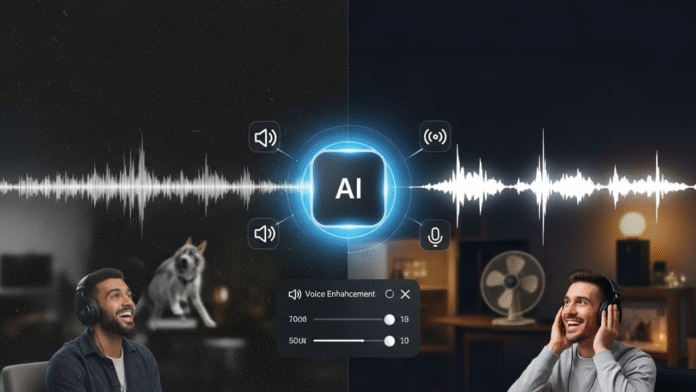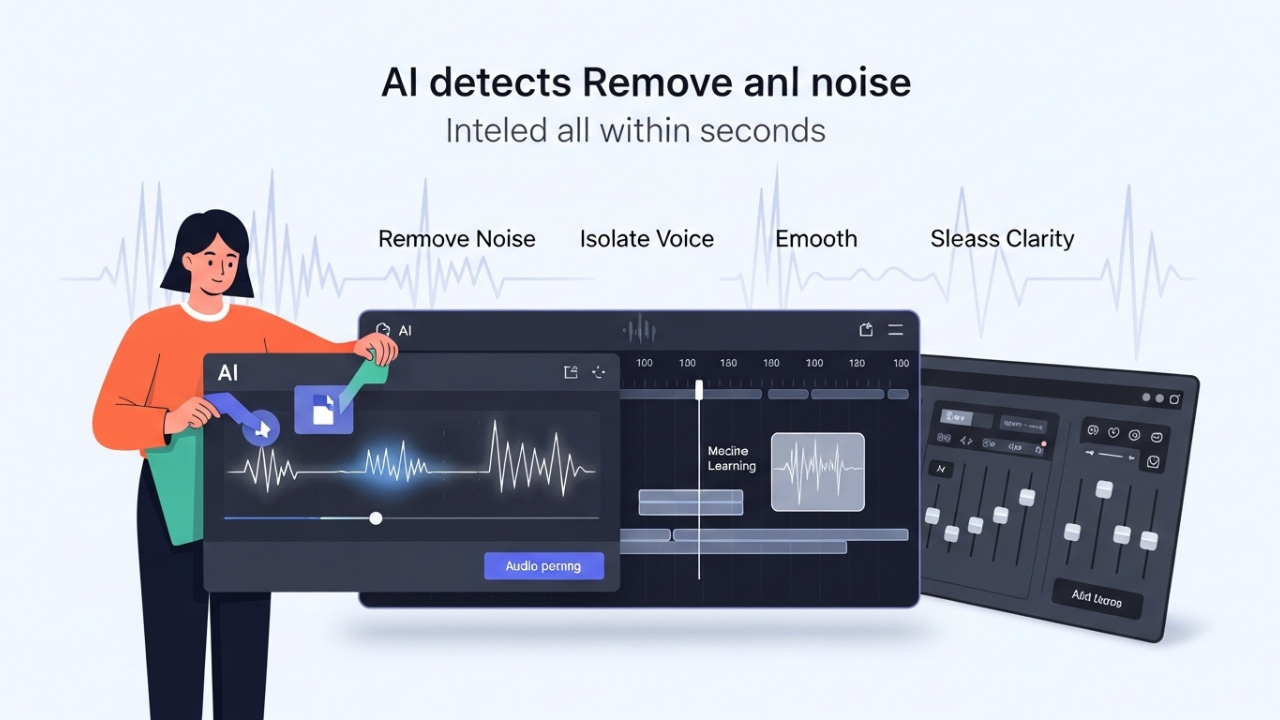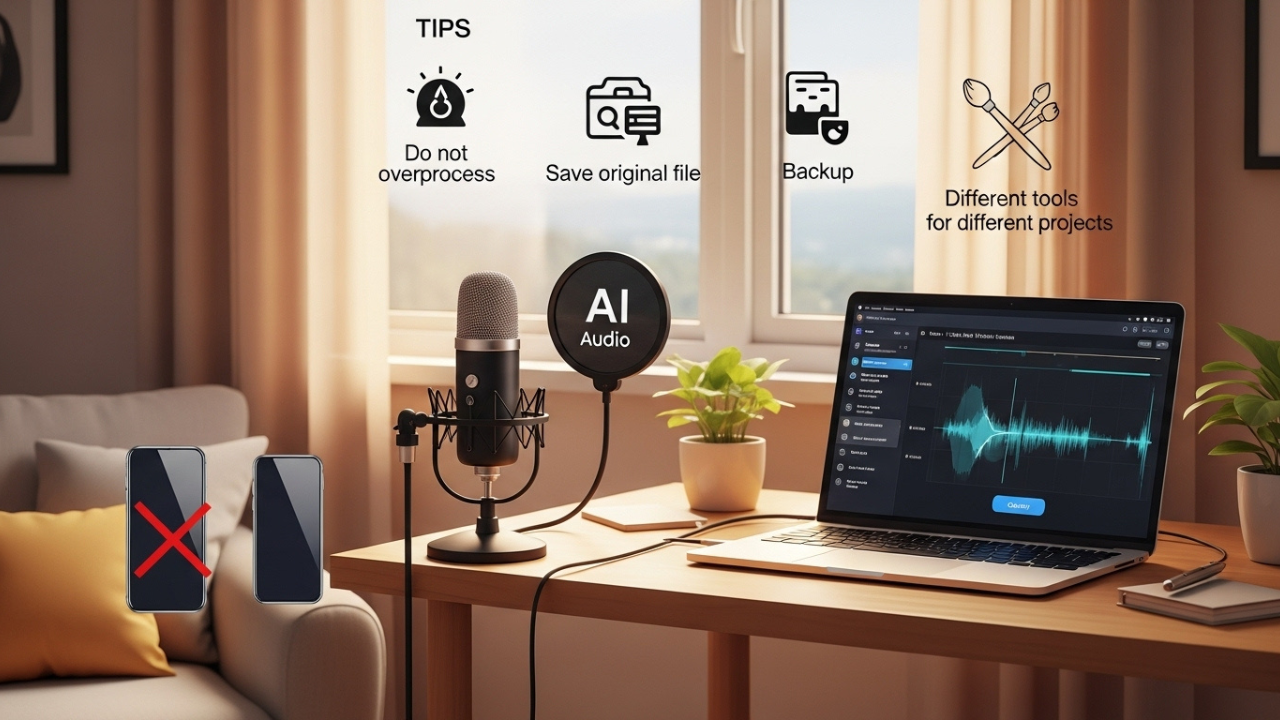Turn Bad Audio into Studio-Quality Sound: The Best AI Tools for Cleaning Up Audio
Have you ever listened to a voice memo or a podcast recording or a YouTube recording and cringed at your voice? Perhaps it was a fan hum or the bark of a dog in the street or the sound of your voice reflected in naked walls. You preferred your audio to be clear and clean and what you received was like a tunnelled effect.
You are not the only one. Actually, it is a rather widespread issue of creators, remote workers, musicians, and even students. Good audio is able to override good content. That is where AI tools enter the scene they clean up the messy recordings, give them a more professional sound, and sometimes it only needs a single button press.
Whether you’re a complete beginner or someone tired of wrestling with editing software, this guide is here to help you understand exactly how to use AI tools to clean up your audio — without the tech overwhelm.
What Does Cleaning Audio Really Mean?
Audio cleaning up is not only the background noise removal. It has got to do with making your voice or sound heard better. That may imply smoothing away harsh sounds, increasing low passages, eliminating buzz or hissing, or even editing out a reverberation created by recording in a big or an empty area.
Bad sound is not only irritating but it destroys credibility. Consider hearing a tutorial or a podcast with noise in the background all the time. It is difficult to concentrate and even more to believe what the speaker says. Take the opposite of that: clean voice-over puts even unstructured material into a truly professional and credible light.
The good news? You don’t need to learn complicated editing. AI makes it simpler than ever before.
How AI Makes Audio Clean-Up Easier
Cleaning audio was once not too long ago a labour-intensive process. You would put your file into a timeline, put a few filters, twist equalisers and hope that it would work. If you were new to audio editing, the process was confusing at best.
Now? You end up having to drag and drop a file, then, secondly, AI listens to you. It tells where the voice lies, where the noise lies, and what people want to be better. In a few seconds, it provides you with a refined one – and will not require you to wiggle a single slider.
This isn’t magic. It’s machine learning trained on thousands of real recordings. It knows the difference between a voice and a refrigerator buzz. It knows what a podcast should sound like. And it keeps getting better.
What Can AI Fix in Your Audio?
Different tools offer different levels of clean-up. But most AI-based systems target the same set of problems.
Noise Reduction
The most common use. Whether it’s street traffic, laptop fans, or someone rustling paper in the background, AI can reduce or completely remove these unwanted sounds. If you’ve ever recorded near a window or in a busy home, this is a lifesaver.
Voice Isolation
Artificial intelligence will allow to take your voice out of any other element: noise, music, background speech, or chatter. It also causes the voice to sound more acute and closer, as a professional recording booth was at your disposal.
Echo Removal
Recording in a room with bare walls can make your voice sound like it’s bouncing. AI can reduce or cancel out that “empty room” effect. This is huge for people recording in small apartments or shared spaces.
Volume Balancing
Some parts of a recording might be loud, others too quiet. AI detects these inconsistencies and adjusts them so your audio has an even, steady level — easier on the ears and more professional overall.
Audio Restoration
Have an old recording with crackles, distortion, or odd frequencies? AI tools have the potential of clarifying some files that you considered as unusable. This becomes particularly helpful in the case of identifiers involved with journalists, researchers, or the content creators utilizing the archival material.
Real Story: How Anna Fixed Her Podcast Without a Studio
Anna runs a small podcast from her bedroom. She has no soundproofing, no expensive mic, and no audio engineer. She used to spend three hours per episode trying to fix messy recordings using free editing software, with very little success.
One day, she tried a tool called Adobe Podcast AI. She uploaded her raw audio — full of chair squeaks, AC hum, and uneven volume. In under five minutes, the tool cleaned it up. Her voice came through clearly, background noise faded away, and the episode sounded like it came from a studio.
Anna’s words stayed the same. But her delivery sounded more professional. That made her feel more confident — and helped her grow her audience.
That’s the power of AI. It doesn’t write your content. It just helps people hear it clearly.
Choosing the Right AI Tool for Your Need
Not all tools are created equal, and you don’t need the fanciest one to get good results. The right tool depends on who you are, what device you’re using, and how much time you want to spend learning.
Let’s take a quick look at some of the most helpful AI tools available today:
Tool Comparison (Google Snippet Style Table)
| Tool Name | Best For | Free Version | Key Features | Output Quality |
| Adobe Podcast AI | Voice-only recordings | Yes | Background removal, voice boost | Very High |
| Auphonic | Podcasters & Youtubers | Yes | Leveling, background noise, loudness | High |
| Krisp | Live calls and meetings | Yes | Real-time noise cancellation, echo fix | Medium |
| Descript Studio Sound | Content editing & audio correction | Free trial | Studio enhancement, transcript editing | Very High |
These tools don’t just clean audio — they fit into your workflow. Whether you’re recording on your phone or editing a full interview series, there’s something that works for your setup.
First Time? Here’s How to Start Cleaning Audio With AI
Let’s say you’re starting fresh. No editing experience, just a raw audio file you recorded on your phone or mic.
- Pick an AI tool — Adobe Podcast AI is beginner-friendly
- Upload your recording.
- Let the AI analyze and clean it.
- Download the processed version.
- Compare it to your original — you’ll hear the difference instantly.
No advanced controls, no audio jargon. Just a cleaner, clearer sound.
Real-Life Scenarios: Where AI Audio Clean-Up Changes Everything
Case 1: The Teacher Recording Lessons at Home
Linda teaches history online. Her laptop mic picks up her voice… and everything else: kids playing in the hall, a ticking clock, and occasional background chatter. She doesn’t have time to re-record every lesson.
With Krisp, Linda sets up real-time background noise cancellation. Now, as she records, the sounds around her are removed live. Her lessons sound focused and clean — and her students stay more engaged.
Case 2: The Podcaster Interviewing Guests Remotely
Jason runs a weekly podcast. He interviews guests over Zoom, but their audio quality is all over the place. One guest used AirPods in a coffee shop.
Instead of editing manually, Jason ran the entire conversation through Auphonic, which leveled the voices, cut background noise, and removed echo from the guest’s mic. The result? Clear audio from both ends — and a podcast episode he was proud to publish.
Case 3: A YouTuber Cleaning Up Outdoor Dialogue
Mei is a YouTube creator who shoots cooking content in her backyard. Wind, birds, distant cars — they all make her dialogue hard to hear.
She uses Descript’s Studio Sound. It separates her voice from the environment and amplifies it. Now, viewers can follow every step of her recipe — without turning up the volume or guessing what she said.
These aren’t just audio tweaks. These are moments where AI tools save time, improve quality, and make creative work feel more professional.
Tips to Get Better Results with AI Audio Tools
Even the best tool won’t fix a recording that’s completely unusable. But with just a bit of care, you can help the AI help you.
Record in a Controlled Environment
Even if AI can remove background noise, give it less to clean. Close windows. Turn off fans. Record in a room with furniture or curtains to reduce echo. You don’t need a studio — just some awareness.
Use a Decent Microphone When Possible
Your phone mic can work, but a $30 external mic can make a noticeable difference. Even a USB mic plugged into your laptop gives AI more to work with.
Avoid Overprocessing
Some tools let you adjust how “strong” the clean-up is. Do not overdo it. Audio that is overprocessed may be robotic, thin or unnatural. Let your voice stay human.
Keep the Original File
Always save your unedited version. If the AI process doesn’t go well, you’ll want a backup. Some tools overwrite files — make sure yours doesn’t.
Test Different Tools for Different Projects
One tool might work great for voiceovers. Another might be better for music. Try more than one before locking into a workflow. Think of AI tools like brushes — not all are for the same job.
Common Mistakes to Avoid When Using AI to Clean Audio
Mistake 1: Expecting AI to Fix Everything
If your voice is too quiet, buried in noise, and recorded on a shaky phone next to a fan — even AI will struggle. Take it as a helper not the magic bullet.
Mistake 2: Using the Wrong Export Format
Some tools default to compressed formats (like MP3). That’s fine for publishing, but always export a high-quality file first (like WAV). You can compress it later if needed.
Mistake 3: Not Reviewing the Output
AI makes fast edits — but it doesn’t listen like a human. Always play the cleaned audio before sharing. Occasionally it can clobber a word or mumble a syllable under breath.
Mistake 4: Forgetting to Adjust Settings
Many AI tools have sliders for noise level, vocal clarity, or room sound. Play with them. Sometimes a 10% shift makes the result feel more natural.
My Opinion| Clean Audio Builds Confidence
Clean sound isn’t just about being heard — it’s about being taken seriously. When people can hear you clearly, they listen longer. They trust you more. They feel connected.
AI tools don’t take over your voice. They make sure your voice gets the spotlight it deserves.
So whether you’re sharing lessons, stories, music, or advice — give your sound the attention it deserves. Clean it. Share it. And let it make an impact.



